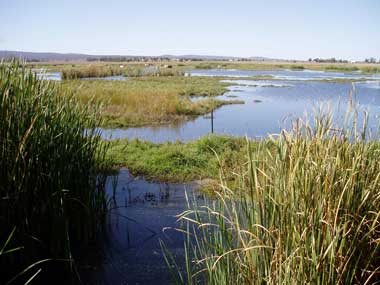The Fivebough and Tuckerbil Swamps Ramsar site is located in the Riverina region of New South Wales, near the township of Leeton, south-east of Griffith. Fivebough Swamp is situated less than 10 kilometres from the seasonal Tuckerbil Swamp. Fivebough Swamp is a permanent, but fluctuating, fresh-brackish, shallow wetland and Tuckerbil Swamp is a seasonal, shallow, brackish-saline wetland. Surrounded by grazing and irrigated land, both wetlands operate as important biodiversity refuges within a landscape altered by human activity. Fivebough and Tuckerbil Swamps are of national and international importance due to the presence, abundance and diversity of waterbirds recorded there, including migratory waterbirds and threatened species. Threatened species include the Australasian Bittern, Brolga and Painted Snipe. The predominant vegetation of the Ramsar site consists of grasses and salt-tolerant succulents. The swamps hold significant value to the local indigenous people, with the area around Fivebough Swamp considered likely to contain historical relics, while Tuckerbil Swamp is a traditional hunting and fishing area for the Wiradjuri peoples. The Koonadan Historic Site near Tuckerbil Swamp is of cultural heritage significance to the Wiradjuri, as an ancestral burial ground. Fivebough Swamp is currently being managed for conservation, education and research, with part of the area leased for grazing purposes. Tuckerbil Swamp, while leased for grazing purposes, is also managed for the purposes of waterbird conservation.
Fivebough and Tuckerbil Wetlands

Government evidence of impact of climate change:
-
Australian Government, Fivebough and Tuckerbil Wetlands Ramsar Site, Ecological Character Description
Key threats to the ecological character of the Fivebough and Tuckerbil Wetlands Ramsar site have been identified as hydrological changes to the wetlands; changes to vegetation communities; innapropriate grazing regimes; introduced weeds and pest animals; poor water quality; climate variation; human disturbance and fire.
Climate is characterised by hot summers and cool winters; with temperatures generally exceeding 30 Celsius in the summer months.
Climate is characterised by hot summers and cool winters; with temperatures generally exceeding 30 Celsius in the summer months (Figure 13).
Climate variation High Medium to long term Climatic predictions point to a warming and drying trend over south eastern Australia and this has significant implications for the hydrology of Fivebough and Tuckerbil Wetlands.
Climate variation It is widely accepted that Australia’s climate will undergo significant changes over the coming decades.
Docilo Rangos Highest on Rocord Very Much Abowo Avorage Above Average Averago 2 Below Average Very Much Below Average Lowost on Record Mean Temperature Deciles (ACORN SAT) 1 November 2012 to 31 October Distribution Based on Gridded Data Product of the National Climate Centre Figure 18.
Despite potential increases in intense rainfall events; climate change predictions point toward an overall reduction in annual rainfall over south eastern Australia (Hughes 2003).
Increased water temperature associated with climate change may also threaten the ecological character of Fivebough and Tuckerbil Wetlands.
Fire Wetlands in the southern catchments of the Murray Darling Basin are particularly vulnerable to the impacts of climate change due to predicted increases in temperatures and declining rainfall (Pittock Finlayson 2011) and fire frequency is also expected to increase with climate change (CSIRO 2011).
Black Box (Eucalyptus largiflorens) associations which used to dominate both wetlands have been lost due to clearing; land use and changes in hydrological and fire regimes.
This; combined with changes in fire regime; resulted in the loss of the Black Box community from Fivebough Wetland.
Increased fire risk or frequency is a potential threat to Fivebough and Tuckerbil Wetlands.
Fire has altered the vegetative assemblages in the past.
However; herbaceous species; including weeds; may gain a competitive advantage as a result of fire if intervals are too low; thus causing changes to the optimal vegetative assemblages at the site.
Environmental impacts from over consumption have been exacerbated by drought in recent times with decreasing river flows and increasing salinity (Ladson 2008).
November 2012 to October 2013 mean temperature deciles for Australia. (Source Australian Bureau of Meteorology) The best estimate of annual average warming by 2030 (above 1990 temperatures) is around 1 1.2 C in inland areas; with drying more likely in southern areas of Australia due to a contraction in the rainfall belt towards the higher latitudes of the southern hemisphere (CSIRO 2011).
The combination of drying and increased evaporation means soil moisture is likely to decline over much of southern Australia.


